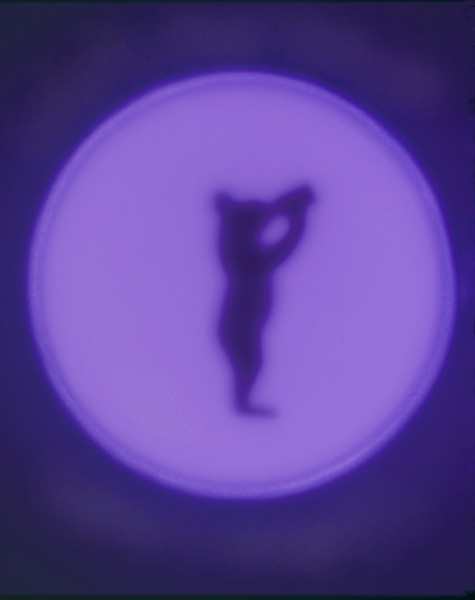
“DRINKING BEAR” Autoradiograph, exposed with uranium, by Peter Gruner Shellenberger, 2009. |
This year's Maine College of Art faculty exhibition at the Institute of Contemporary Art offers up a hearty sampling of work from a range of departments. Grouped under the theme of "Archaeology Above Ground," the four artists featured don't have much of a dialogue, but stand just fine on their own. The show is always a great reminder of the talent bundled up in the Congress Street building, and proof that a strong studio practice is achievable while teaching — the work in the show was all completed in 2009. The exhibition is fairly sparse, allowing a lot of room to experience the work and inspiring a Dia:Beacon-esque serenity in the galleries. The artists are divvied up in the four gallery spaces, each definitely vibrating at a different frequency, some begging for a step closer and some a step back.
Peter Shellenberger's "nuclear" prints are the loudest works in the show, with two monumental wall-size prints and seven smaller prints of kitschy silhouettes glowing in neon purple spotlights. Clever in their process and perplexing in product, his images are the result of flea-market savvy and experimentation with the science of photography. Discovering that the red glaze on early Fiestaware contains uranium oxide, which continues to be radioactive, Shellenberger exposed dinner plates to film for 45 days, shadowing the results with Cracker Jack toys from the same era. The resulting works are eerie, carnivalesque, and sexy — a girl rollerskates in her hazy pink Petri dish, or a gun sits smugly in a nostalgic flushed bubble.
While Shellenberger's images are insular, Meg Brown Payson's acrylic on panel "Horizon/Hot Autumn" expands to line an entire gallery with a cross section of some abstracted microbial swamp. Forming a literal horizon in the space, 30 some-odd panels surround the viewer, creating the sensation of being within a bacterial terrarium. The painting begins with a saturated earthy green color field, varying from warm to cool as it circles the room. Organic forms reminiscent of amoeba, or perhaps less-found-in-nature coffee stains, oil spills, or soda can connectors layer over the initial green in hot oranges, reds, and yellows, familiar but resisting definition. Each panel is developed with countless layers of washes, drips, and intentional marks to build a rich texture and depth. A balance of abstract expressionistic whim and articulated form is meditative, attempting to derive order from chaos.
Also exploring our perception of ecosystems, jeweler Tina Rath shifts from the human body to the gallery walls with "Wanderlux (Phase 1)," a delicate and scattered installation collecting in the front gallery. Using opulent materials such as ivory, mink, sterling, and African blackwood, Rath interprets smaller organisms found in the forest to decadent effect. Lichen, bark, barnacles, and small blooms are meticulously crafted and arranged on a series of rosy maple blocks geometrically affixed to the wall. The installation is minimal, and feels a bit underwhelming in the large gallery, but each of the tiny specimens is gorgeous, achieving a glossy homage to the origin of the lavish materials.